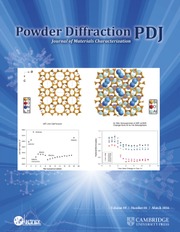Article contents
History of the dichotomy method for powder pattern indexing
Published online by Cambridge University Press: 01 March 2012
Abstract
A short history of the developments of the successive dichotomy method for powder pattern indexing is presented. In the first computer powder indexing programs (P1 and P2), only high lattice symmetries, down to orthorhombic, were considered [Louër and Louër, J. Appl. Crystallogr. 5, 271–275 (1972)]. Later on, an extension to the monoclinic symmetry was reported in DICVOL, including a partition of the volume space to first search solutions with smaller unit cell volumes [Louër and Vargas, J. Appl. Crystallogr. 15, 542–545 (1982)]. However, CPU times were slow in some monoclinic examples. A thorough mathematical analysis resulted in a significant optimization of the CPU times [Boultif and Louër, J. Appl. Crystallogr. 24, 987–993 (1991)]. Simultaneously, the method is extended to triclinic lattices. The stages of development of the various versions of the DICVOL program are described, with a particular emphasis on DICVOL91 (Boultif and Louër, 1991) and DICVOL04 [Boultif and Louër, J. Appl. Crystallogr. 37, 724–731 (2004)]. This article is written to testify to and emphasize the major role played by Daniel Louër, who introduced the successive dichotomy method and continued to its evolution and optimization over almost 40 years.
Information
- Type
- Invited Articles
- Information
- Copyright
- Copyright © Cambridge University Press 2005
References
- 9
- Cited by

